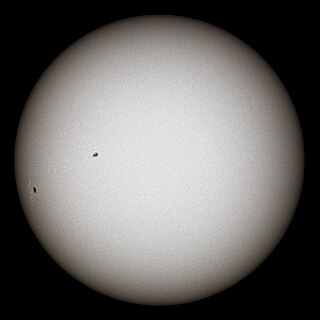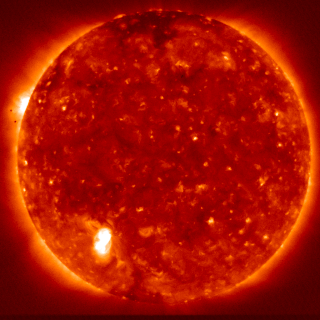Related Research Articles

Luminosity is an absolute measure of radiated electromagnetic power (light), the radiant power emitted by a light-emitting object over time. In astronomy, luminosity is the total amount of electromagnetic energy emitted per unit of time by a star, galaxy, or other astronomical objects.

A solar flare is an intense localized eruption of electromagnetic radiation in the Sun's atmosphere. Flares occur in active regions and are often, but not always, accompanied by coronal mass ejections, solar particle events, and other solar phenomena. The occurrence of solar flares varies with the 11-year solar cycle.

Space weather is a branch of space physics and aeronomy, or heliophysics, concerned with the time varying conditions within the Solar System, including the solar wind, emphasizing the space surrounding the Earth, including conditions in the magnetosphere, ionosphere, thermosphere, and exosphere. Space weather is distinct from, but conceptually related to, the terrestrial weather of the atmosphere of Earth. The term "space weather" was first used in the 1950s and came into common usage in the 1990s. Later, it was generalized to a "space climate" research discipline, which focuses on general behaviors of longer and larger-scale variabilities and effects.
The jansky is a non-SI unit of spectral flux density, or spectral irradiance, used especially in radio astronomy. It is equivalent to 10−26 watts per square metre per hertz.

The solar cycle, also known as the solar magnetic activity cycle, sunspot cycle, or Schwabe cycle, is a nearly periodic 11-year change in the Sun's activity measured in terms of variations in the number of observed sunspots on the Sun's surface. Over the period of a solar cycle, levels of solar radiation and ejection of solar material, the number and size of sunspots, solar flares, and coronal loops all exhibit a synchronized fluctuation from a period of minimum activity to a period of a maximum activity back to a period of minimum activity.

STS-72 was a Space Shuttle Endeavour mission to capture and return to Earth a Japanese microgravity research spacecraft known as Space Flyer Unit (SFU). The mission launched from Kennedy Space Center, Florida on 11 January 1996.
In radiometry, irradiance is the radiant flux received by a surface per unit area. The SI unit of irradiance is the watt per square metre (W⋅m−2). The CGS unit erg per square centimetre per second (erg⋅cm−2⋅s−1) is often used in astronomy. Irradiance is often called intensity, but this term is avoided in radiometry where such usage leads to confusion with radiant intensity. In astrophysics, irradiance is called radiant flux.

The Crab Pulsar is a relatively young neutron star. The star is the central star in the Crab Nebula, a remnant of the supernova SN 1054, which was widely observed on Earth in the year 1054. Discovered in 1968, the pulsar was the first to be connected with a supernova remnant.
The AB magnitude system is an astronomical magnitude system. Unlike many other magnitude systems, it is based on flux measurements that are calibrated in absolute units, namely spectral flux densities.

Solar cycle 24 is the most recently completed solar cycle, the 24th since 1755, when extensive recording of solar sunspot activity began. It began in December 2008 with a minimum smoothed sunspot number of 2.2, and ended in December 2019. Activity was minimal until early 2010. It reached its maximum in April 2014 with a 23 months smoothed sunspot number of 81.8. This maximum value was substantially lower than other recent solar cycles, down to a level which had not been seen since cycles 12 to 15 (1878-1923).

In astronomy and in astrophysics, for radiative losses of the solar corona, it is meant the energy flux radiated from the external atmosphere of the Sun, and, in particular, the processes of production of the radiation coming from the solar corona and transition region, where the plasma is optically-thin. On the contrary, in the chromosphere, where the temperature decreases from the photospheric value of 6000 K to the minimum of 4400 K, the optical depth is about 1, and the radiation is thermal.
A Crab is a standard astrophotometrical unit for measurement of the intensity of Astrophysical X-ray sources. One Crab is defined as the intensity of the Crab Nebula at the corresponding X-ray photon energy.
The Bastille Day solar storm was a powerful solar storm on 14-16 July 2000 during the solar maximum of solar cycle 23. The storm began on the national day of France, Bastille Day. It involved a solar flare, a solar particle event, and a coronal mass ejection which caused a severe geomagnetic storm.

In solar physics, a solar particle event (SPE), also known as a solar energetic particle (SEP) event or solar radiation storm, is a solar phenomenon which occurs when particles emitted by the Sun, mostly protons, become accelerated either in the Sun's atmosphere during a solar flare or in interplanetary space by a coronal mass ejection shock. Other nuclei such as helium and HZE ions may also be accelerated during the event. These particles can penetrate the Earth's magnetic field and cause partial ionization of the ionosphere. Energetic protons are a significant radiation hazard to spacecraft and astronauts.

The POlarization Emission of Millimeter Activity at the Sun (POEMAS) is a solar patrol system composed of two radio telescopes with superheterodyne circular polarization receivers at 45 and 90 GHz. Since their half power beam width is around 1.4°, they observe the full sun. The acquisition system allows to gather 100 values per second at both frequencies and polarizations, with a sensitivity of around 20 solar flux units (SFU) (1 SFU ≡ 104 Jy). The telescope saw first light in November 2011, and showed excellent performance during two years, when it observed many flares. Since November 2013 is stopped for repairing. The main interest of POEMAS is the observation of solar flares in a frequency range where there are very few detectors and fill the gap between microwaves observed with the Radio Solar Telescope Network (1 to 15.4 GHz) and submillimeter observations of the Solar Submillimeter Telescope (212 and 405 GHz). Moreover, POEMAS is the only current telescope capable of carrying on circular polarization solar flare observations at 90 GHz. (Although, in principle, ALMA band 3 may also observe at 90 GHz with circular polarization).

Explorer 43, also called as IMP-I and IMP-6, was a NASA satellite launched as part of Explorer program. Explorer 43 was launched on 13 March 1971 from Cape Canaveral Air Force Station (CCAFS), with a Thor-Delta M6 launch vehicle. Explorer 43 was the sixth satellite of the Interplanetary Monitoring Platform.

SN 2018cow was a very powerful astronomical explosion, 10–100 times brighter than a normal supernova, spatially coincident with galaxy CGCG 137-068, approximately 200 million ly (60 million pc) distant in the Hercules constellation. It was discovered on 16 June 2018 by the ATLAS-HKO telescope, and had generated significant interest among astronomers throughout the world. Later, on 10 July 2018, and after AT 2018cow had significantly faded, astronomers, based on follow-up studies with the Nordic Optical Telescope (NOT), formally described AT 2018cow as SN 2018cow, a type Ib supernova, showing an "unprecedented spectrum for a supernova of this class"; although others, mostly at first but also more recently, have referred to it as a type Ic-BL supernova. An explanation to help better understand the unique features of AT 2018cow has been presented. AT2018cow is one of the few reported Fast Blue Optical Transients (FBOTs) observed in the Universe. In May 2020, however, a much more powerful FBOT than AT2018cow was reportedly observed.

The solar storms of August 1972 were a historically powerful series of solar storms with intense to extreme solar flare, solar particle event, and geomagnetic storm components in early August 1972, during solar cycle 20. The storm caused widespread electric‐ and communication‐grid disturbances through large portions of North America as well as satellite disruptions. On 4 August 1972 the storm caused the accidental detonation of numerous U.S. naval mines near Haiphong, North Vietnam. The coronal mass ejection (CME)'s transit time from the Sun to the Earth is the fastest ever recorded.

PSR J0952–0607 is a massive millisecond pulsar in a binary system, located between 3,200–5,700 light-years (970–1,740 pc) away from Earth in the constellation Sextans. It holds the record for being the most massive neutron star known as of 2022, with a mass 2.35±0.17 times as much as the Sun—potentially close to the Tolman–Oppenheimer–Volkoff mass upper limit for neutron stars. The pulsar rotates at a frequency of 707 Hz, making it the second-fastest-spinning pulsar known, and the fastest-spinning pulsar known within the Milky Way.
References
- ↑ Tapping, K. F. (2013). "The 10.7 cm solar radio flux (F10.7)". Space Weather. 11 (7): 394–406. Bibcode:2013SpWea..11..394T. doi: 10.1002/swe.20064 .